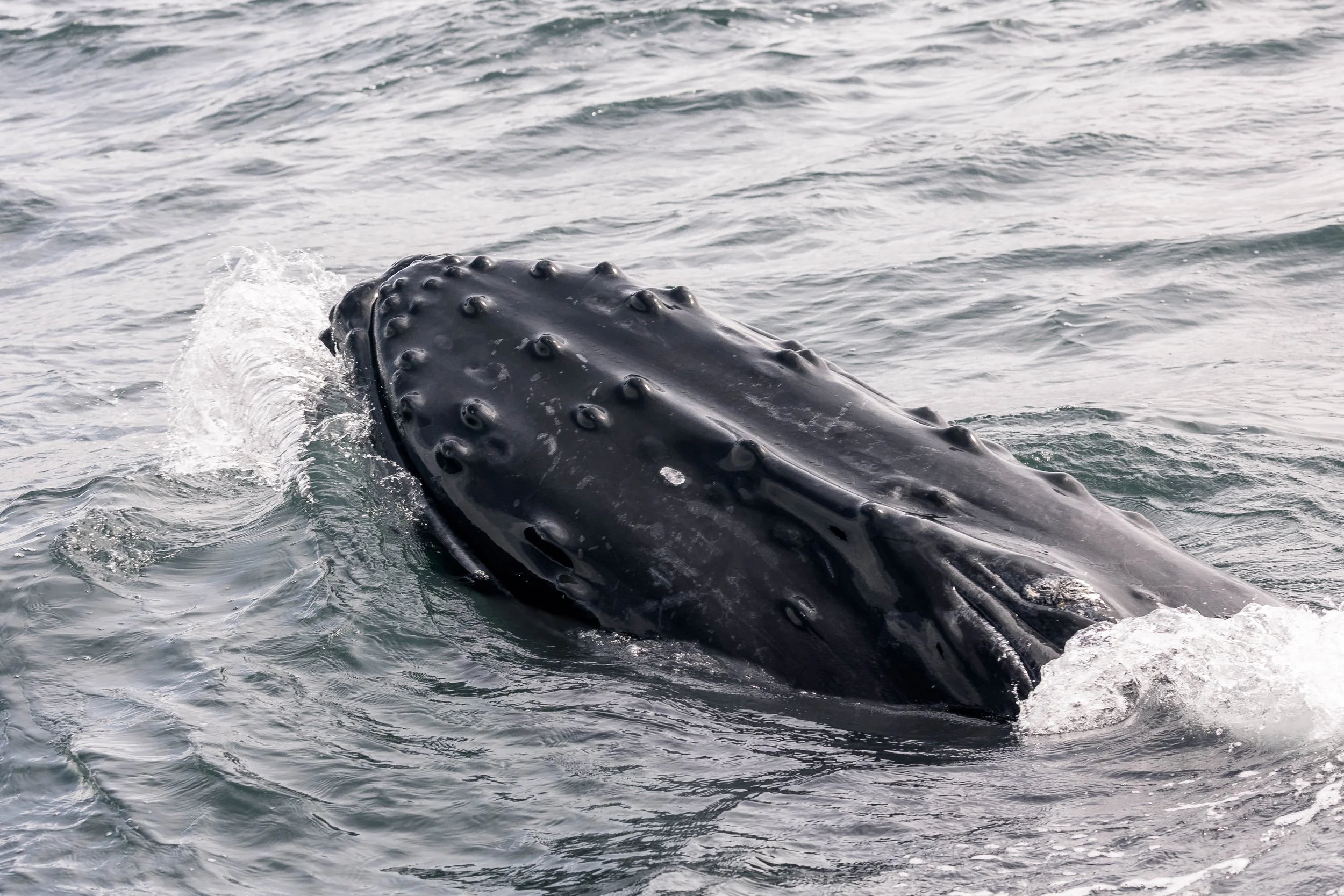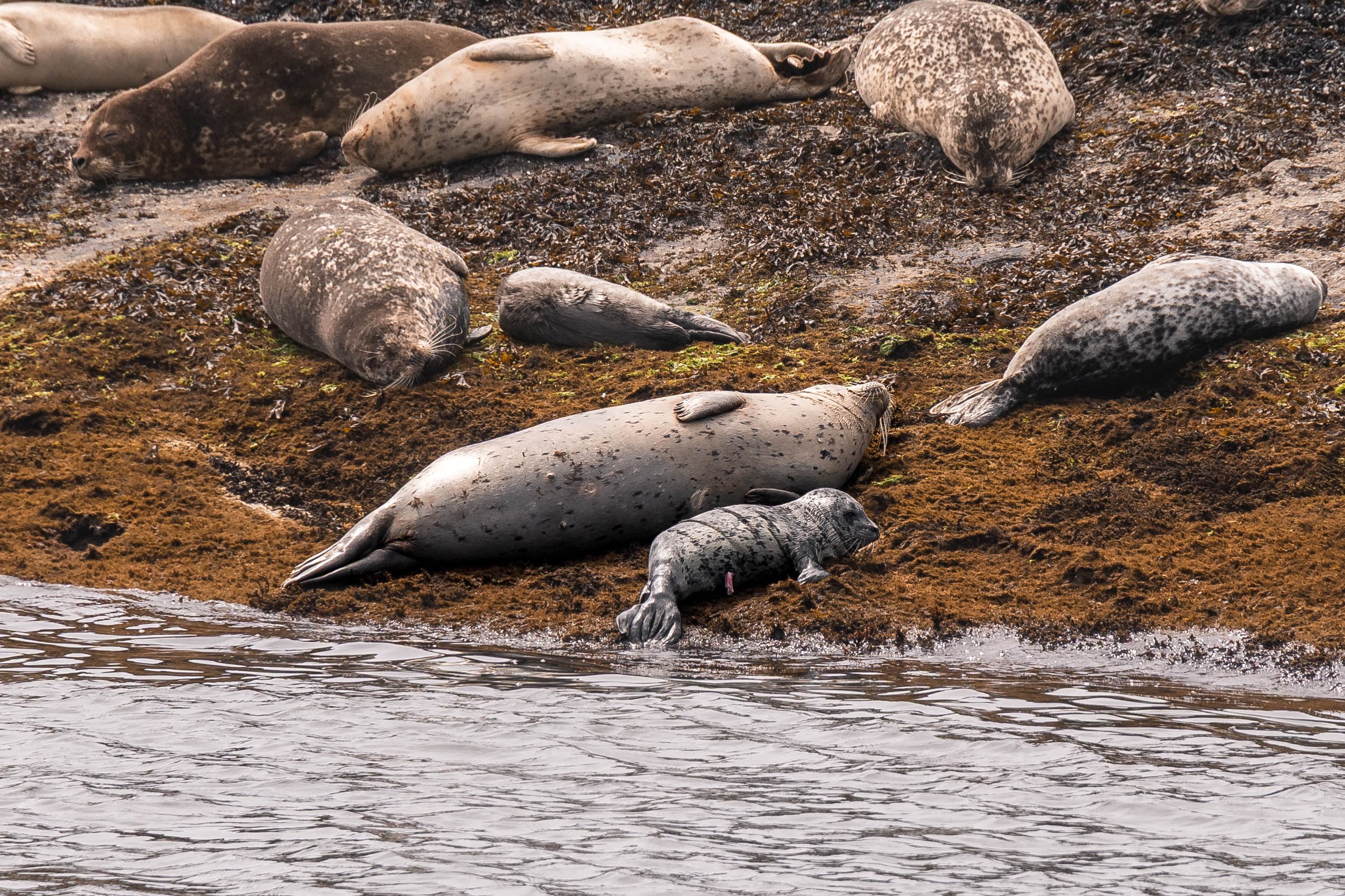July 25, 2025, 10:30 AM - Humpbacks north of Nanaimo.
On this lovely morning, our whole fleet set off into the Salish Sea! Vessels Kula, Cascadia, and Keta departed the dock and headed north in search of some whales. As our vessels adventured towards the shore of Pipers Lagoon, some humpback whales had been spotted!
It took us a couple of minutes to get a final count on how many we had. We were very fortunate to stumble upon a group of 4 humpbacks! Next, the cameras came out for identification photos, we are always eager to find out who we are with and who is associating with whom! It was a group of youngsters and a friend. We used those large, distinct tails to get our IDs. We had Hammer (BCY1222), who was born in 2019 to Claw, making them 6 years old. Mow (KEY0063), the 2023 calf of Graze, was the next one we identified. Moe’s only 2 years old. Galaxia (BCZ0573), born to Andromeda in 2021, was the next young humpback we had in the group, a 4-year-old. We also had a fourth humpback in the mix, whose identification we were unable to get, and it remains unknown. We guess it was most likely a young whale as well, but until we get an ID, we can only assume. Stay tuned to our blog, if we can find a match for our unknown’s dorsal fin (we did not get a photo of their tail), we will update this blog!
Young humpback whales are often full of energy and curiosity, and they can be surprisingly playful. These juveniles are frequently seen rolling at the surface, twisting and turning in the water, often lifting their flukes or pectoral fins high into the air. This playful behaviour is not only endearing to watch but may serve important developmental purposes, helping calves build muscle, learn coordination, and explore the limits of their buoyant bodies.
They also spend a lot of time socializing and associating with one another. Young whales, particularly those who have recently weaned, can sometimes be found in loose groups, travelling or resting together. These associations may be short-term, but they allow the young whales to learn from one another, mimic behaviours, and practice the social skills they’ll need as adults.
One amusing behaviour to observe is bubble-blowing. While adult humpbacks in some areas use bubble nets to corral prey, juveniles may blow bubbles simply for play. Streams or rings of bubbles released at the surface or underwater may not have any feeding purpose at all; instead, they could be a form of self-entertainment or communication. Combined with rolling, tail slapping, and playful lunges, these young whales often look like they’re just enjoying themselves, reminding us that even the ocean’s giants have a playful side. While watching this playful quartet, we saw some blows in the distance and one of the open boats headed over to find out who they were.
It was a couple of familiar fins, Yakima (BCX2182) and Holey Moley (BCY1220). These two were most likely feeding. As we watched them, we could see a red blob expanding on the surface. These humpbacks were defecating! Humpback whale poop might not be glamorous, but it’s a great sign for researchers and naturalists; it means the whale has been feeding! These massive animals eat thousands of pounds of plankton, krill and small schooling fish like herring and sand lance each day during the summer months, and seeing a cloud of reddish-brown waste at the surface is a sure sign their foraging has been successful. Because humpbacks don’t eat during their long migration or while in their breeding grounds, spotting poop in feeding areas like the Salish Sea tells us they’re actively refuelling and building up fat reserves for the journey ahead. We left these two to bulk up and carried on to see a few more members of the Salish Sea before heading back to Nanaimo.
During our tours, we often come across a lively mix of coastal wildlife! Rocky outcrops and remote islets serve as home to some of the Salish Sea’s most charismatic residents, including Steller Sea Lions, harbour seals, cormorants, and bald eagles. Seeing them all in one trip is a real treat and a reminder of the rich biodiversity of this coastal ecosystem.
Steller Sea Lions are hard to miss with their massive size and loud, guttural roars. The males can weigh over 2,500 pounds and are often seen piled together on haulouts, bickering for the best sunbathing spots. A fun fact: despite their bulk, Steller’s are incredibly agile in the water, in search of prey like fish and squid.
Harbour seals, on the other hand, are much more reserved. These spotted marine mammals can often be seen lounging on the rocks in small groups, peeking at us with wide, curious eyes. They’re sometimes called “water puppies” for their rounded faces and expressive features. A neat fact about harbour seals: pups can swim just minutes after birth, an important survival trait in these coastal environments.
Cormorants, with their sleek black bodies and sharp hooked beaks, are often seen drying their wings after diving. Unlike many seabirds, their feathers aren’t fully waterproof, which actually helps them dive and chase fish underwater. One fun fact: cormorants have been trained by fishermen in parts of Asia for centuries to help catch fish, using a small ring around their necks to prevent them from swallowing the catch!
Finally, soaring overhead or perched on treetops, we often spot the unmistakable silhouette of a bald eagle. These impressive raptors are expert hunters and scavengers, known for their piercing calls and massive wingspans, up to 8 feet wide! A cool fact: despite being a national symbol of strength, bald eagles are notorious for stealing food from other birds, a trait known as kleptoparasitism.
Together, these animals create a dynamic coastal community, each species playing a role in the ecosystem and offering guests an incredible window into life on the edge of land and sea.
Photos below by Jordan Robinson, Hayleigh Hilbert and Vanessa Vereschahen.
Hammer’s dorsal fin. Photo by Hayleigh Hilbert
The corner of Mow’s fluke. Photo by Vanessa Vereschahen
Holey Moley rolling around. Photo by Hayleigh Hilbert
Yakima going down. Photo by Hayleigh Hilbert
Holey Moley diving. Photo by Hayleigh Hilbert
Mow’s fluking. Photo by Vanessa Vereschahen
Hammer fluking. Photo by Vanessa Vereschahen
Galaxia with a tail flick. Photo by Jordan Robinson
A fluke waterfall from Yakima. Photo by Hayleigh Hilbert
Yakima diving. Photo by Hayleigh Hilbert
An interesting angle. Photo by Vanessa Vereschahen
Coming up! Photo by Hayleigh Hilbert
Can you spot the fist sized bumps on the jaw? These are called tubercles. Photo by Hayleigh Hilbert
A rostrum lift. Photo by Hayleigh Hilbert
Can you spott the nursing harbour seal pup? Photo by Hayleigh Hilbert
Some sleepy harbour seals Photo by Jordan Robinson
A harbour seal snoozing with her pup. Photo by Hayleigh Hilbert
So plump. Photo by Vanessa Vereschahen
A harbour seal and her pup. Photo by Vanessa Vereschahen
A cuddle puddle of Steller Sea Lions. Photo by Hayleigh Hilbert
A posing Steller. Photo by Vanessa Vereschahen
A male Steller Sea Lion. Photo by Vanessa Vereschahen
Someone is not happy! Photo by Vanessa Vereschahen
A bald eagle on the rocks. Photo by Vanessa Vereschahen
A cormorant at the Gabriola Bluffs. Photo by Vanessa Vereschahen
A gull at the Bluffs. Photo by Vanessa Vereschahen



























